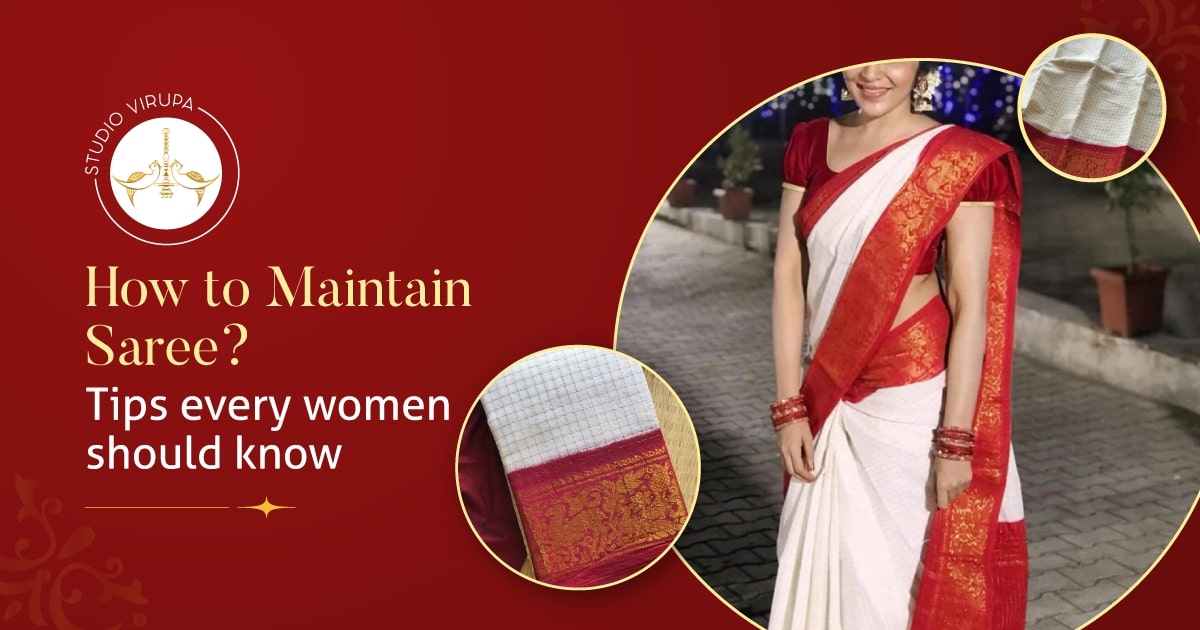How to Maintain Saree? 10 Tips Every Woman Should Know
The saree, a timeless symbol of Indian culture, is more than just a piece of clothing. It's a canvas of vibrant colours, intricate designs, and rich heritage. But like any treasured possession, sarees require proper care to maintain their beauty and longevity. Fear not, saree enthusiasts! This guide unveils the secrets on how to maintain saree flawlessly.
We'll explore ten essential tips, from washing techniques specific to different fabrics to clever storage solutions. Whether you're a seasoned saree connoisseur or a curious newcomer, this guide will equip you with the knowledge to keep your sarees looking their absolute best. So, let's delve into the art of saree care and ensure your beloved drapes continue to tell their stories for years to come!
The saree, a captivating drape that transcends generations, deserves the utmost care to retain its brilliance. With a little knowledge and practice, you can become a saree guardian, ensuring your collection stays vibrant and heirloom-worthy.
An Extended Guide to Mastering Saree Maintenance
1. The Storage Sanctuary: A Breathable Haven
- Embrace Natural Fibers: Instead of airtight plastic containers that trap moisture, opt for breathable cotton bags or woven baskets. These allow air circulation, preventing mustiness and mildew growth, which can damage delicate fabrics.
- Location, Location, Location: Store your sarees in a cool, dry place away from direct sunlight. Sunlight can cause fading, especially for sarees with vibrant colours. Choose a shelf or cupboard in a well-ventilated area.
- Cedar Power: Consider placing a few cedar blocks or sachets filled with cedar chips amongst your sarees. Cedarwood naturally repels moths and other insects that can damage fabrics.

2. Washing Wisdom: Tailoring Care to the Fabric
- Know Your Fabric: The key to washing sarees lies in understanding the fabric. Delicate fabrics like chiffon or georgette require gentle hand-washing with a mild detergent specifically formulated for delicates.
- Cotton and Silk TLC: For sturdier fabrics like cotton or silk, dry cleaning might be the safest option. However, if the care label allows for handwashing, use lukewarm water and a mild detergent. Avoid harsh chemicals or bleaches.
- Pre-Soaking for Protection: For sarees with intricate embellishments or rich colours, pre-soaking in cold water with a little salt for 15-20 minutes can work wonders. This helps set the colours and prevent bleeding or colour transfer during the washing process.
3. The Power of Gentle Techniques
- Ditch the Washing Machine: The harsh tumbling of a washing machine can damage delicate sarees. Opt for gentle hand-washing instead.
- Knead Don't Scrub: Instead of aggressively scrubbing your sarees, use gentle kneading motions to remove dirt. This prevents fraying and maintains the delicate weave of the fabric.
4. Drying Delights: Avoiding Sun and Harsh Methods
- Sun's Kiss of Fade: Skip the dryer! The high heat can shrink or damage the fabric. Instead, hang your sarees on a padded hanger or lay them flat on a drying rack in a shaded area.
- Clipping Concerns: Avoid using clothespins directly on the saree fabric, especially for delicate materials. The clips can leave marks or indentations. If hanging is necessary, use clothespins on the saree's blouse (choli) or petticoat (inner skirt).
5. Ironing Intelligence: Protecting Your Saree with the Right Heat
- Iron on the Reverse: Always iron your sarees on the reverse side to avoid scorching the delicate fabric.
- Heat Settings Matter: Consult the care label for the recommended ironing temperature for the specific fabric. Using the wrong heat setting can damage the fibres.
- Muslin Magic: For added protection, place a muslin cloth between the iron and the saree while ironing. This acts as a barrier and prevents iron marks.
6. Perfume Perfection: Avoiding Fragrance Faux Pas
- Sprit Before You Drape: To prevent perfume stains and damage to the delicate fabric, apply perfume before draping your saree. Let the perfume dry completely before wearing it.
- Targeted Spritzing: Instead of spraying perfume directly on the saree, target areas like your pulse points or behind your ears.
7. Embrace the Expertise of Professionals
8. Stain Slayer Solutions: Acting Fast for Flawless Fabric
- Swift Action is Key: The quicker you address a stain, the easier it will be to remove. Act fast! Blot the affected area with a clean, absorbent cloth. Never rub, as this can spread the stain further.
- Natural Remedies: For certain stains, natural remedies like baking soda or club soda might be effective. However, always test the remedy on an inconspicuous area of the saree first to ensure it doesn't cause discolouration.
- Professional Help for Stubborn Stains: For stubborn stains that you can't remove yourself, consult a professional dry cleaner who specialises in saree care.
9. Breathe Easy: Preventing Mustiness with Regular Airing
- Freshness is Key: To prevent mustiness, air out your sarees occasionally.
- Sunlight Savvy: While avoiding direct sunlight for storage, choose a bright, sunny day (not too harsh) to air out your sarees. Spread them on a clothesline or flat surface in a shaded outdoor area for a few hours. Sunlight has natural disinfecting properties and can help eliminate any lingering dampness.
10. Natural Moth Repellents: Keeping Pests at Bay
- Natural Powerhouses: Instead of harsh chemical moth repellents, opt for natural alternatives like neem leaves or sachets filled with dried lavender. Place these sachets amongst your stored sarees to keep moths and other insects away.
- Cedar's Allure: As mentioned earlier, cedar chips or blocks are another natural and effective way to repel moths.
- Bonus Tip: Folding with Care
- Folding Finesse: The way you fold your sarees can impact their longevity. Avoid sharp folds that can cause creases to set permanently. Opt for loose folds or gentle rolling techniques to store your sarees.
Studio Virupa: Where Tradition Meets Modern Artistry
We at Studio Virupa are dedicated to showcasing the classic elegance of sarees, a love that spans three generations. Every strand of these exquisite clothes reflects our commitment to quality. Every saree in our collection tells a tale weaved with love, custom, and heritage—it's more than just an article of apparel. We have carefully chosen our selection to pay tribute to this rich past while skillfully incorporating contemporary components. Whether you're looking for something classic or modern, our sarees are made to support you in making your own special memories. Our sarees are designed to make you feel unique and treasured, whether for big events or casual elegance.
Come explore our stunning sarees at Studio Virupa; you're sure to discover the ideal saree to commemorate your important occasions. Allow us to assist you in infusing your clothing with a hint of classic beauty, bringing back fond memories with each drape.
Takeaway
Maintaining your sarees isn't just about keeping them looking good; it's about preserving a cultural legacy. By following these simple tips, you can ensure your sarees continue to grace generations to come. From delicate silks to breezy cotton, you'll now possess the knowledge to care for each saree with the respect it deserves.So go forth, drape yourself in elegance, and embrace the art of saree care! With a little effort, your sarees will continue to be cherished possessions, whispering stories of tradition and timeless beauty.
FAQs for How to Maintain Saree
1. How should I store my sarees to keep them in good condition?
Store sarees in a cool, dry place. Use breathable fabric bags or cotton covers to prevent moisture buildup. Avoid plastic covers as they can trap humidity, leading to mildew.
2. How can I prevent my sarees from developing creases?
To prevent creases, always fold your sarees along the original folds. For delicate sarees like silk, consider rolling them instead of folding them. Using padded hangers for heavier sarees can also help maintain their shape.
3. What is the best way to wash cotton sarees?
Hand wash cotton sarees separately in cold water using a mild detergent. Avoid wringing them out; instead, gently squeeze out excess water and dry them in the shade to prevent colour fading.
4. How should I care for my silk sarees?
Dry clean silk sarees to preserve their sheen and texture. If you must wash them at home, use a mild soap, cold water, and avoid soaking. Always dry them in the shade and store them with neem leaves or silica gel to keep pests away.
5. How can I maintain the zari work on my sarees?
To maintain zari work, avoid washing the saree frequently. When necessary, gently dry clean them. Store zari sarees in muslin cloths and avoid contact with perfumes, deodorants, and moisture to prevent tarnishing.
6. What are some tips for ironing sarees without damaging them?
Iron sarees on a low to medium setting. Place a thin cloth over the saree to protect it from direct heat. For delicate fabrics like silk, use a steam iron or get them professionally pressed.
7. How can I remove stains from my sarees effectively?
Treat stains as soon as possible. For food or oil stains, sprinkle talcum powder or cornflour to absorb the oil, then brush off gently. For tougher stains, use a mild detergent or stain remover suitable for the fabric, and always test on a small area first. Dry clean if necessary.


